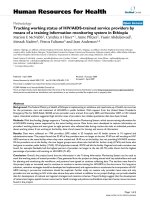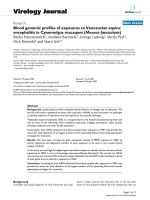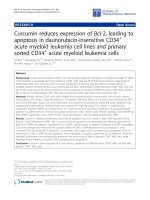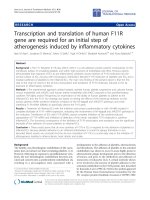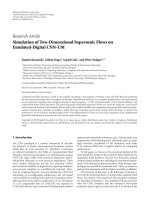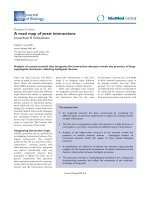Báo cáo sinh học: "Estimation by simulation of the efficiency of the French marker-assisted selection program in dairy cattle (Open Access publication)" ppsx
Bạn đang xem bản rút gọn của tài liệu. Xem và tải ngay bản đầy đủ của tài liệu tại đây (90.24 KB, 12 trang )
“g07007” — 2007/12/14 — 8:50 — page 91 — #1
✐
✐
✐
✐
✐
✐
✐
✐
Genet. Sel. Evol. 40 (2008) 91–102 Available online at:
c
INRA, EDP Sciences, 2008 www.gse-journal.org
DOI: 10.1051/gse:2007036
Original article
Estimation by simulation of the efficiency
of the French marker-assisted selection
program in dairy cattle
(Open Access publication)
François Guillaume
1,2∗
, Sébastien Fritz
3
, Didier Boichard
1
,
Tom D
ruet
1
1
INRA, UR337 Station de génétique quantitative et appliquée, 78350 Jouy-en-Josas, France
2
Institut de l’élevage, 149 rue de Bercy, 75595 Paris Cedex 12, France
3
Union nationale des coopératives d’élevage et d’insémination animale, 149 rue de Bercy,
75595 Paris Cedex 12, France
(Received 19 January 2007; accepted 3 September 2007)
Abstract – The efficiency of the French marker-assisted selection (MAS) was estimated by
a simulation study. The data files of two different time periods were used: April 2004 and
2006. The simulation method used the structure of the existing French MAS: same pedigree,
same marker genotypes and same animals with records.The program simulated breeding values
and new records based on this existing structure and knowledge on the QTL used in MAS
(variance and frequency). Reliabilities of genetic values of young animals (less than one year
old) obtained with and without marker information were compared to assess the efficiency of
MAS for evaluation of milk, fat and protein yields and fat and protein contents. Mean gains of
reliability ranged from 0.015 to 0.094 and from 0.038 to 0.114 in 2004 and 2006, respectively.
The larger number of animals genotyped and the use of a new set of genetic markers can explain
the improvement of MAS reliability from 2004 to 2006. This improvement was also observed
by analysis of information content for young candidates. The gain of MAS reliability with
respect to classical selection was larger for sons of sires with genotyped progeny daughters
with records. Finally, it was shown that when superiority of MAS over classical selection was
estimated with daughter yield deviations obtained after progeny test instead of true breeding
values, the gain was underestimated.
marker-assisted selection / simulation / efficiency / dairy cattle
∗
Corresponding author:
Article published by EDP Sciences and available at
or />“g07007” — 2007/12/14 — 8:50 — page 92 — #2
✐
✐
✐
✐
✐
✐
✐
✐
92 F. Guillaume et al.
1. INTRODUCTION
Marker-assisted selection (MAS) is expected to be particularly valuable for
dairy cattle breeding [2,6]. Indeed, several conditions in which MAS improves
the efficiency of classical selection are met: most traits of interest are sex-
limited, generation interval is long and progeny-test is a long and costly step.
Furthermore, MAS can increase the reliability of breeding values [7]. This
would be particularly beneficial for bull dams, which are often selected on
pedigree information only [2] or for functional traits, with a low heritabil-
ity, that are gaining emphasis in breeding goals. Therefore, since the end of
2000, a MAS program has been implemented in France. Breeding companies
joined this program in order to improve their selection efficiency. However,
since MAS programs are recent and relatively rare, little is known about their
efficiency. Indeed, the progeny testing step is relatively long and a compar-
ison of breeding values predicted by MAS before and after progeny testing
can be done only more than four years after first MAS predictions. In addition,
the number of progeny tested bulls remains limited to estimate MAS efficiency
and to draw conclusions. Finally, the true breeding values are unknown and this
adds some sampling error. Simulation studies offer the possibility to increase
the number of animals and to repeat the analysis, to know the true breeding
values and to have direct answers. Different simulation studies [6, 8, 12] have
already proven the efficiency of MAS for predicting breeding values. However,
simulation studies are often based on simple hypotheses. Thanks to the infor-
mation accumulated in the French MAS program since 2000, it is now possi-
ble to make more realistic assumptions regarding the population structure, the
marker informativity, the number of genotyped animals, the number of animals
with records and the precision of these records, etc. Variances of the QTL used
are also better known because they have been estimated recently on a large
data sample [3]. The objective of this study was to estimate by simulation the
efficiency of the French MAS evaluation for two different time periods.
2. MATERIAL AND METHODS
2.1. Fr ench MAS data
Data sets used for French MAS evaluation of April 2004 and 2006 were
used in this study. Two different time periods were studied to observe the evo-
lution of the efficiency of MAS. Indeed, the efficiency of MAS should be im-
proved in 2006 because more families were genotyped, dams of young animals
were more often genotyped and some new microsatellite markers were used.
“g07007” — 2007/12/14 — 8:50 — page 93 — #3
✐
✐
✐
✐
✐
✐
✐
✐
Efficiency of marker assisted selection 93
Table I. Population structure of the French MAS program in April 2004 and 2006.
April 2004 April 2006
Animals in pedigree 34 318 55 336
Animals with records 23 137 38 859
Genotyped animals 16 629 27 551
Male candidates 1180 1689
Sires
1
72 79
Dams
1
793 1130
Genotyped dams
1
486 887
Maternal grand-sires
1
70 114
Sires
1
with more than 20 genotyped progeny daughters 11 12
Progeny tested sire families with 30 sons or more 47 64
1
Of male candidates.
Three files were used at each evaluation: the pedigree file, the markers file
containing the probabilities of transmission for each QTL and the data file.
The pedigree used in the French MAS includes different types of ani-
mals. First, candidates are young males or females aged from 1 month to
1 year of age. These animals can be chosen to be parents in the next gener-
ation. Males can be selected for progeny testing while females can be used as
bull dams. The purpose of MAS is to improve the prediction of breeding values
of these candidates, which are therefore genotyped. It is also advised to geno-
type dams of candidates in order to follow QTL transmission as accurately as
possible. Families of progeny tested bulls or groups of progeny daughters were
genotyped in order to estimate QTL effects of old bulls or younger bulls (sire
of candidates), respectively. Thanks to the genotyped animals, the genotypes
of some other animals (e.g. sires) were reconstructed. In addition, the pedigree
file contained parents over two generations of all these animals. Table I indi-
cates the number of candidates (with their sires and dams), genotyped dams,
number of genotyped progeny tested bulls or progeny daughter families.
Animals were genotyped for 43 and 45 microsatellite markers before and
after first of January 2005, respectively. These markers are used to follow
the transmission of 14 QTL regions [1]. Seven of these QTL affecting milk
production or composition traits were used in this study. Two to five mi-
crosatellite markers are available for each QTL. These were used to esti-
mate probability of identity-by-descent (pid) matrices using a method simi-
lartothatofWanget al. [15] extended to the use of multiple markers as in
Pong-Wong et al. [10].
“g07007” — 2007/12/14 — 8:50 — page 94 — #4
✐
✐
✐
✐
✐
✐
✐
✐
94 F. Guillaume et al.
Finally, phenotypic records were twice the daughter yield deviations (DYD)
for males and yield deviations (YD) for females computed for milk, fat and
protein yields and fat and protein percentages, pooled from the first three lac-
tations jointly as in VanRaden and Wiggans [14]. These records were ob-
tained from the official genetic evaluation of April 2004 [11]. Respective
weights were estimated as in VanRaden and Wiggans [14] with a correction
for the number of cows in each herd. DYD of sires were obtained by using
only records of daughters not included in the pedigree file. These phenotypic
records were replaced by simulation.
2.2. Simulation
The pedigree file and the file containing pid were exactly the same as in
the real MAS program. The structure of the performance file was also kept:
the same animals had records and the weights of the records were conserved.
Only the records were simulated with the following method. The genetic effect
of animal i is computed as
g
i
= u
i
+
n_qtl
j=1
(v
ij1
+ v
ij2
)
where u
i
is the polygenic effect of individual i (excluding QTL effects), v
ij1
and v
ij2
are allelic effects at QTL j for the paternal and maternal alleles, re-
spectively, and n_qtl is the number of QTL.
For animals without parents, the polygenic effect was sampled from N(0,
σ
2
u
) while for animals with parents, the polygenic effect was equal to the sum
of the mean polygenic effects of the parents and the Mendelian sampling drawn
from a normal distribution with the variance adjusted for number of known
parents. The polygenic variance (σ
2
u
) was defined according to the heritability
of the traits and the proportion of genetic variance explained by QTL (Tab. II).
For each QTL j, a biallelic gene with substitution effect α
j
was simulated.
The estimated percentage of heterozygous sires in the population was used to
approximate the allelic frequency in the population. The substitution effect was
derived from the simulated QTL variance and the allelic frequencies. The vari-
ances used for each QTL for each trait are presented in Table II. These were
obtained from Druet et al. [3] and from our knowledge of these QTL. For all
founder animals, QTL alleles were sampled thanks to the allelic frequencies.
Then, the alleles were transmitted to the entire population using the estimated
pid. By definition, the pid gives the probability for an offspring to receive the
“g07007” — 2007/12/14 — 8:50 — page 95 — #5
✐
✐
✐
✐
✐
✐
✐
✐
Efficiency of marker assisted selection 95
Table II. Proportion of genetic variance used to simulate QTL effects for dairy traits
and polygenic effect (in %).
Number of the chromosome on Polygenic Heritability
which the QTL is located effect of the traits
Trait 3 6 7 14 19 20 26
Milk yield 0 0 5 15 0 10 10 60 0.30
Fat yield 0 5 5 15 5 0 20 50 0.30
Protein yield 0 5 5 10 5 0 10 65 0.30
Fat content 0 5 5 40 0 10 0 40 0.50
Protein content 10 15 0 10 0 15 0 50 0.50
paternal or the maternal allele from its parent. Therefore, these probabilities
were used to simulate which QTL allele an offspring had received from its par-
ent. For instance, if the pid was equal to 0.5, the progeny had equal chances to
receive the paternal or the maternal allele of its parent while if the paternal pid
was equal to 1 then the progeny received the paternal allele of the correspond-
ing parent.
To simulate records, a residual value was sampled from N(0, σ
2
e
) where the
residual variance is adjusted by the weight from actual phenotypes in the MAS
data set. The simulated records were the sum of the genetic and residual val-
ues. Additionally, for male candidates, records were simulated with a weight
corresponding to the first EBV obtained after progeny testing.
Simulations were repeated 100 times for each trait and both time periods.
2.3. MAS evaluation
The model used in this study was a single trait and multi-QTL model as
proposed by Fernando and Grossman [4]:
y = Xβ + Zu+
n_qtl
i=1
Z
v
i
v
i
+e (1)
where y is a vector containing records, β is a vector of fixed effects (the mean),
u is a vector of random polygenic effects, v
i
is a vector of random gametic
effects for QTL i and e is a vector of random residual terms. X, Z and Z
vi
are known design matrices that relate records to fixed, random polygenic and
gametic effects, respectively.
Four to five QTL were used for each production trait and the variance com-
ponents (see Tab. II) were assessed based on a previous study [3].
“g07007” — 2007/12/14 — 8:50 — page 96 — #6
✐
✐
✐
✐
✐
✐
✐
✐
96 F. Guillaume et al.
Table III. Mean information content measured as |1–2p| weighted by QTL variance
for each trait for 2004 and 2006 candidates and their parents.
Traits
Mean information content weighted by QTL variance
Candidates Sires Dams
2004 2006 2004 2006 2004 2006
Milk 0.61 0.72 0.36 0.47 0.44 0.54
Fat yield 0.58 0.72 0.33 0.48 0.41 0.54
Protein yield 0.60 0.71 0.34 0.48 0.43 0.55
Fat content 0.70 0.76 0.40 0.49 0.50 0.56
Protein content 0.72 0.75 0.41 0.53 0.52 0.60
3. RESULTS
3.1. Simulated data
The results were obtained for two different sets of candidates (Tab. I).
They included males born during the previous AI season, i.e. from October to
September. The first set was constituted of candidates of year 2004 whereas the
second set of candidates of year 2006. Informativity was estimated as |1 − 2p|
where p was the probability transmission of a given paternal or maternal QTL
allele [2]. When the transmitted allele is known, p is equal to 0 or 1 and
1 − 2p
is one while when there is no information on which allele was transmitted,
pisequalto0.5and
1 − 2p
is zero. So this information content indicates how
well the QTL transmission is followed in the population. For each trait, mean
information content was computed by weighting the information content of
each QTL by the proportion of genetic variance explained by this QTL. This
weighted mean information content is presented in Table III for candidates of
years 2004 and 2006 and for their sires and dams. For all the traits, information
content increased in 2006 with respect to 2004: for candidates, mean informa-
tion content gains ranged from +0.03 up to +0.14 while for sires they ranged
from +0.09 up to +0.15. The gains were comprised between +0.06 and +0.13
for dams.
3.2. Estimation model
Marker-assisted selection was compared to classical selection (model with
only a polygenic effect). Accuracies of breeding values (squared correlation R
2
between estimated and true genetic effects) were estimated and are presented
in Table IV. For all traits, MAS EBV were more reliable than classical EBV.
“g07007” — 2007/12/14 — 8:50 — page 97 — #7
✐
✐
✐
✐
✐
✐
✐
✐
Efficiency of marker assisted selection 97
Table IV. Reliabilities (R
2
) of classical polygenic EBV (POL) and MAS EBV (MAS)
for male candidates from 2004 and 2006.
Trait
April 2004 April 2006
POL MAS Difference POL MAS Difference
Milk yield 0.294 0.327 +0.033 0.313 0.361 +0.048
Fat yield 0.281 0.296 +0.015 0.310 0.373 +0.063
Protein yield 0.254 0.273 +0.019 0.303 0.341 +0.038
Fat content 0.313 0.407 +0.094 0.342 0.453 +0.111
Protein content 0.214 0.301 +0.087 0.342 0.418 +0.076
Table V. Reliabilities of classical polygenic EBV (POL) or marker-assisted EBV
(MAS) of candidates of 2004, depending on the status of their sires.
Trait
Sires of candidates Sires of candidates with
without genotyped genotyped progeny
progeny daughters daughters
POL MAS Difference POL MAS Difference
Milk yield 0.266 0.302 +0.036 0.291 0.353 +0.062
Fat yield 0.255 0.263 +0.008 0.277 0.312 +0.035
Protein yield 0.243 0.265 +0.022 0.267 0.307 +0.040
Fat content 0.269 0.384 +0.115 0.304 0.476 +0.172
Protein content 0.200 0.301 +0.101 0.210 0.372 +0.162
In 2004, the gain of reliability ranged from 0.015 for fat yield up to 0.094
for fat content. Gain was relatively limited for yield traits (0.033, 0.015 and
0.019 for milk, fat, and protein yields, respectively) and larger for content traits
(0.094 and 0.087 for fat and protein contents, respectively). In 2006, the dif-
ference between MAS EBV and classical EBV was larger, especially for yield
traits (0.048, 0.063 and 0.038 for milk, fat and protein yields, respectively).
Among all 100 replications for 2004, MAS was less efficient than classical
selection for eleven and nine replications for fat and protein yields, respec-
tively. In 2006, MAS resulted in lower reliabilities for a single replication for
milk yield. For these few negative results, the difference between evaluation
methods was close to zero.
In 2004, MAS and classical EBV were also compared with respect to
the amount of information available to estimate gametic effects of the sires
(Tab. V). Two classes of sires were defined: sires with or without genotyped
progeny daughters (at least 20). The improvement of accuracy due to MAS
is larger for all traits when a group of progeny daughters is also genotyped.
The difference between MAS selection and classical selection when sires of
candidates have no genotyped progeny represent only 59, 23, 55, 67 and 63%
“g07007” — 2007/12/14 — 8:50 — page 98 — #8
✐
✐
✐
✐
✐
✐
✐
✐
98 F. Guillaume et al.
Table VI. Correlations between classical polygenic EBV (POL) or marker-assisted
EBV (MAS) and simulated DYD of candidates of 2004.
Trait POL SAM
Difference
Mean St. Dev. Minimum Maximum
Milk yield 0.476 0.502 +0.026 0.013 –0.002 0.074
Fat yield 0.466 0.477 +0.011 0.018 –0.041 0.051
Protein yield 0.441 0.457 +0.016 0.014 –0.021 0.056
Fat content 0.526 0.599 +0.073 0.022 0.022 0.135
Protein content 0.522 0.572 +0.052 0.020 0.013 0.097
of the difference obtained when sires have genotyped progeny for milk, fat and
protein yields and fat and protein contents, respectively.
Finally, the comparisons between MAS and classical EBV with simulated
DYD (with an accuracy corresponding to first EBV after progeny testing) are
shown in Table VI. As expected, MAS EBV are better predictors but the differ-
ence between MAS and classical selection varies across replications. The mean
correlation gain is equal to 0.026, 0.011, 0.016, 0.073 and 0.052 for milk, fat
and protein yield and fat and protein content, respectively. These gains are
lower than when comparison is done with true genetic values (comparison on
an accuracy scale). The minimum and maximal gains ranged from –0.002 to
0.074, –0.041 to 0.051, –0.021 to 0.056, 0.022 to 0.135 and from 0.013 to
0.097 for milk, fat and protein yields and fat and protein contents, respectively.
For some samples, MAS appeared to perform worse than the classical model
for fat or protein yield.
4. DISCUSSION
Files involved in the French MAS are increasing on a regular basis as a
consequence of continuous addition of new genotyped animals (see Tab. I).
Therefore, the MAS evaluation is more demanding in computational terms but
the information on QTL is increasing with time. More families are genotyped
and QTL transmission is better observed. Both these information improve the
estimation of QTL effects and therefore the efficiency of MAS. The increment
of genotyped animals is not only due to the continuous application of the MAS
program but also to strategic choices decided to improve the French MAS pro-
gram. For instance, breeding companies genotype dams of candidates more
frequently than at the start of the MAS program. At the beginning, neither the
dams of sire nor the progeny daughter families were genotyped. During the
MAS program, breeding companies were advised to genotype these animals.
“g07007” — 2007/12/14 — 8:50 — page 99 — #9
✐
✐
✐
✐
✐
✐
✐
✐
Efficiency of marker assisted selection 99
The impact of all these decisions is visible in Table III where increasing in-
formation can be noted. Some technical changes were also implemented to
improve the efficiency of MAS. Some microsatellite markers are no longer
used while some more informative markers were integrated in the program. All
these elements improved the efficiency of MAS to follow QTL transmission in
the population (see Tab. III). The changes in precision of the pid between 2004
and 2006 are important and are consequences of efforts made by breeding com-
panies. Efficiency of MAS can still be improved by the use of denser markers.
For instance, if informativity is increased by replacing the microsatellite mark-
ers by ten SNP close to the QTL (within 1 cM), the gain of reliability of MAS
with respect to classical selection is increased from 43% up to 79% (data not
shown). As shown, the gain of efficiency achieved by improving the accuracy
of the pid is important but to obtain even larger gains, other MAS strategies
must be applied (such as the use of linkage disequilibrium).
Some previous studies showed the advantage of MAS in predicting breed-
ing values [12, 13]. The present study focused on accuracy gain rather than
genetic progress gain achievable by MAS; in fact the latter criterion is greatly
dependent on the selection strategy whereas accuracy of prediction reflects the
methodology efficiency more. In the present study, many conditions were those
really applied in the French breeding schemes (pedigree, markers, genotyped
animals, etc.). Under these conditions, MAS improved the reliability of breed-
ing values but the gain remained limited.
Accuracy improvement appeared larger for content traits than for yield
traits. This can be explained by several facts. For content traits, QTL explained
in general a larger part of the genetic variation. Part of genetic variance ex-
plained by the QTL has a major impact on the efficiency of MAS. Indeed, the
gain of reliability achieved by MAS ranked similarly to the part of variance
explained by the QTL. However, other parameters influence the efficiency of
MAS. For instance, QTL variance is equal for fat yield and protein content but
MAS performed better with protein content. Mean information content was
higher for content traits. The influence of mean information content can also
be seen when comparing the results for yield traits in 2004 and 2006. Effi-
ciency of MAS improved clearly at constant QTL variance thanks to better
mean information content. In addition, MAS is more beneficial, at constant
part of genetic variance explained by the QTL, when there are fewer QTL (but
with larger effects). Indeed, the polygenic model is more appropriate for a situ-
ation with many QTL (closer to the infinitesimal model) than with a few QTL.
Therefore, the superiority of MAS will be reduced with many small QTL. Fi-
nally, QTL effects are estimated more accurately when QTL have larger effects
“g07007” — 2007/12/14 — 8:50 — page 100 — #10
✐
✐
✐
✐
✐
✐
✐
✐
100 F. Guillaume et al.
and when there is less environmental noise. However, for low heritability traits,
gains of reliability of MAS are expected to be larger because there is much
room for improvement since classical selection performs poorly. In the present
study, efficiency of MAS was studied only for heritabilities above 0.30 and no
conclusions can be drawn for low heritability traits.
The number of QTL and proportion of total genetic variance explained by
them are greater than parameters usually assumed by previous simulation stud-
ies [8, 12]. This should enhance MAS efficiency, by reducing the risk that par-
ents are homozygous at all the QTL.
On the contrary to various simulation studies [8, 13], population structure
is fairly unbalanced. As shown in Table I, a few sires and maternal grandsires
contribute heavily to the population. It is essential to evaluate their gametic
effects as accurately as possible. Therefore, it is very important to genotype
many animals such as dams and progeny daughters’ families. Indeed, the re-
sults showed that when sires of candidates have genotyped progeny daugh-
ters, MAS was more efficient. This approach has some similarities with the
Bottom-up scheme proposed by Mackinnon and Georges [7] and which was
shown to increase MAS efficiency. Sires of candidates with genotyped progeny
daughters were just a few (11 out of 72 in 2004 and 12 out of 79 in 2006) but
generally contributed to a large proportion of candidates (20% in 2004 and
25% in 2006). Since the start of the French MAS, efforts have been made to
increase the information available. In 2006, gains of accuracy obtained with
MAS were better than in 2004. All the accumulated information improves the
French MAS programs.
The study also showed that if the efficiency of MAS is assessed with field
data, on DYD for instance, the estimated gain is reduced. Indeed, MAS EBV
are better predictors of true genetic values. DYD still contain some errors and
MAS EBV do not predict these error terms well.
Although many parameters were estimated on real data, the simulation per-
formed in this study might depart from the underlying biological reality. There-
fore, the results presented might over- or under-estimate MAS efficiency. Vari-
ance of the QTL was estimated on a large sample independent from the sample
used for QTL detection. Still, the variances used might be incorrect. Therefore,
the efficiency of MAS was also tested by using under- or over-estimated (by
25%) QTL variances and the differences were marginal: MAS was achiev-
ing the same gains. Allelic frequencies or effects might be wrong or the QTL
could be multi-allelic. The evaluation model should be robust to these changes
and the accuracy of the estimation of QTL effects should not vary much. For
instance, the evaluation model does not assume a fixed number of alleles but
“g07007” — 2007/12/14 — 8:50 — page 101 — #11
✐
✐
✐
✐
✐
✐
✐
✐
Efficiency of marker assisted selection 101
rather an infinite number of alleles and could easily handle a multi-allelic QTL.
Although reliabilities obtained by MAS might be only slightly affected by dif-
ferent allelic frequencies or multi-allelic QTL, the polygenic model might be
more sensitive to the changes and therefore the difference between MAS and
the polygenic model might be over- or under-estimated. However, it is difficult
to predict if the polygenic model would be penalised under different hypothe-
ses. When more parents are heterozygous (due to multi-allelic QTL or changes
in frequencies) and transmission of genetic values departs from the rules used
with the polygenic model (half of the breeding value is transmitted), the poly-
genic model should achieve lower reliabilities.
This is also true when QTL effects are larger because they have a larger
influence in the ranking of the animals. On the contrary, the polygenic model
performs better with many QTL because this situation is closer to the infinites-
imal model.
In this study, QTL were assumed additive but if some QTL had non-additive
effects (dominance, epistasis), the impact on the results would be larger since
the model would be less robust to it.
Finally, MAS will certainly evolve in the future towards more efficient mod-
els using denser marker maps (e.g., Meuwissen et al., [9]) and exploiting
linkage disequilibrium. For instance, Hayes et al. [5] presented advantages
of LD-MAS. With dense maps, small haplotypes around the QTL will be in
linkage disequilibrium with the QTL. Therefore, gametic effects will be esti-
mated across families and no longer within each sire family. As a consequence,
the effects will be estimated more accurately and less genotyped animals will
be required to estimate these effects. In addition, follow-up of transmission of
gametic effects will be more precise because information content will improve.
5. CONCLUSIONS
In the French MAS program, accuracy of breeding values of young candi-
dates was shown to be improved thanks to the use of molecular information.
The obtained gains of accuracy (in comparison with classical selection) were
relatively limited and strongly dependent on the accumulated information in
the program. By genotyping more animals (such as dams or progeny daughters
of sires of candidates) or using better markers, the efficiency of this program
was clearly improved.
Thanks to the development of new genotyping technologies, still improved
results are expected with the use of denser marker maps and of linkage dise-
quilibrium.
“g07007” — 2007/12/14 — 8:50 — page 102 — #12
✐
✐
✐
✐
✐
✐
✐
✐
102 F. Guillaume et al.
REFERENCES
[1] Boichard D., Fritz S., Rossignol M.N., Boscher M.Y., Malafosse A., Colleau
J.J., Implementation of marker-assisted selection in French dairy cattle, in:
Proceedings of the 7th World Congress on Genetics Applied to Livestock
Production, 18–23 August 2002, Montpellier, Communication no. 22-03.
[2] Boichard D., Grohs C., Bourgeois F., Cerqueira F., Faugeras R., Neau A., Rupp
R., Amigues Y., Boscher M.Y., Levéziel H., Detection of genes influencing eco-
nomic traits in three French dairy cattle breeds, Genet. Sel. Evol. 35 (2003) 77–
101.
[3] Druet T., Fritz S., Boichard D., Colleau J.J., Estimation of genetic parameters for
quantitative trait loci for dairy traits in the French Holstein population, J. Dairy
Sci. 89 (2006) 4070–4076.
[4] Fernando R.L., Grossman M., Marker assisted selection using best linear unbi-
ased prediction, Genet. Sel. Evol. 21 (1989) 467–477.
[5] Hayes B.J., Chamberlain A.J., Goddard M.E., Use of markers in linkage dise-
quilibrium with QTL in breeding programs, in: Proceedings of the 8th World
Congress on Genetics Applied to Livestock Production, 13–18 August 2006,
Belo Horizonte, Brazil, Communication no. 30-06.
[6] Kashi Y., Hallerman E., Soller M., Marker-assisted selection of candidate bulls
for progeny testing programmes, Anim. Prod. 51 (1990) 63–74.
[7] Mackinnon M.J., Georges M.A.J., Marker-assisted preselection of young dairy
sires prior to progeny testing, Livest. Prod. Sci. 54 (1998) 229–250.
[8] Meuwissen T.H.E., Goddard M.E., The use of marker haplotypes in animal
breeding schemes, Genet. Sel. Evol. 28 (1996) 161–176.
[9] Meuwissen T.H.E., Hayes B.J., Goddard M.E., Prediction of total genetic value
using genome-wide dense marker maps, Genetics 157 (2001) 1819–1829.
[10] Pong-Wong R., George A.W., Woolliams J.A., Haley C.S., A simple and rapid
method for calculating identity-by-descent matrices using multiple markers,
Genet. Sel. Evol. 33 (2001) 453–471.
[11] Robert-Granié C., Bonaïti B., Boichard D., Barbat A., Accounting for variance
heterogeneity in French dairy cattle genetic evaluation, Livest. Prod. Sci. 60
(1999) 343–357.
[12] Schrooten C., Bovenhuis H., van Arendonk J.A.M., Bijma P., Genetic progress
in multiple stage dairy cattle breeding schemes using genetic markers, J. Dairy
Sci. 88 (2005) 1569–1581.
[13] Spelman R., Bovenhuis H., Genetic response from marker-assisted selection in
an outbred population for differing marker bracket sizes and with two identified
quantitative trait loci, Genetics 148 (1998) 1389–1396.
[14] VanRaden P.M., Wiggans G.R., Derivation, calculation, and use of national
Animal Model Information, J. Dairy Sci. 74 (1991) 2737–2746.
[15] Wang T., Fernando R.L., van der Beek S., Grossman M., van Arendonk J.A.M.,
Covariance between relatives for a marked quantitative trait locus, Genet. Sel.
Evol. 27 (1995) 251–274.
